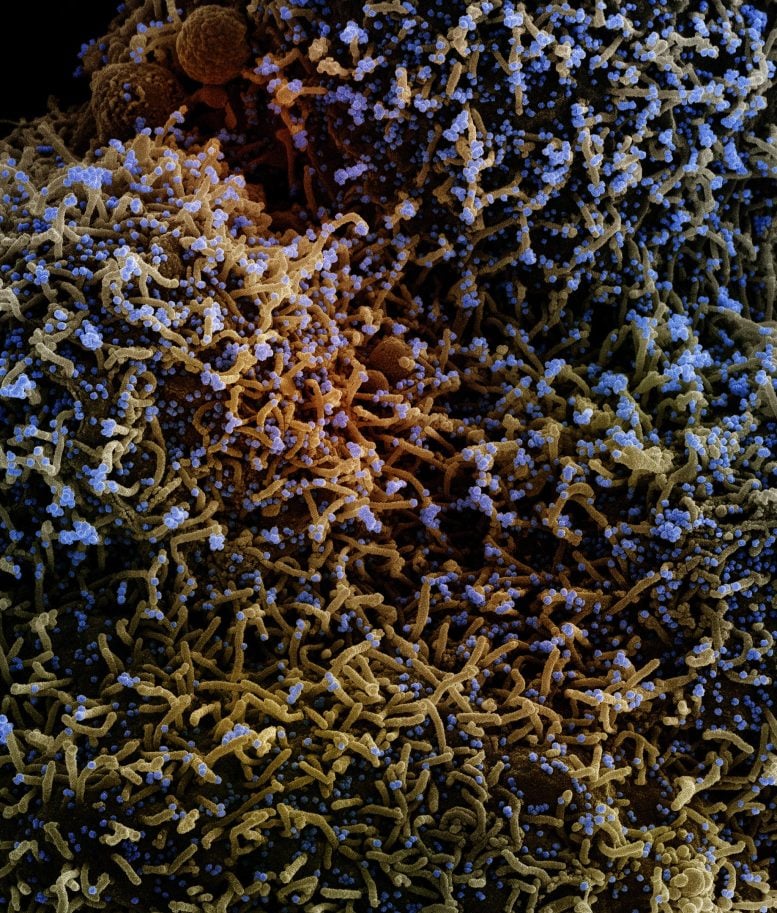Lung Autopsies of COVID-19 Patients Reveal How Virus Spreads and Damages Tissue, Treatment Clues
CT scan of patient’s lungs showing COVID-19 damage in red. Credit: Gerlig Widmann and team, Department of Radiology, Medical University of Innsbruck
SARS-CoV-2 prevents lung tissue repair, regeneration.
Lung autopsy and plasma samples from people who died of COVID-19 have provided a clearer picture of how the SARS-CoV-2 virus spreads and damages lung tissue. Scientists at the National Institutes of Health and their collaborators say the information, published in Science Translational Medicine, could help predict severe and prolonged COVID-19 cases, particularly among high-risk people, and inform effective treatments.
Although the study was small—lung samples from 18 cases and plasma samples from six of those cases—the scientists say their data revealed trends that could help develop new COVID-19 therapeutics and fine-tune when to use existing therapeutics at different stages of disease progression. The findings include details about how SARS-CoV-2, the virus that causes COVID-19, spreads in the lungs, manipulates the immune system, causes widespread thrombosis that does not resolve, and targets signaling pathways that promote lung failure, fibrosis and impair tissue repair. The researchers say the data are particularly relevant to caring for COVID-19 patients who are elderly, obese, or have diabetes—all considered high-risk populations for severe cases. Study samples were from patients who had at least one high-risk condition.
Colorized scanning electron micrograph of a cell infected with a variant strain of SARS-CoV-2 virus particles (blue), isolated from a patient sample. Image captured at the NIAID Integrated Research Facility (IRF) in Fort Detrick, Maryland. Credit: NIAID
The study included patients who died between March and July 2020, with time of death ranging from three to 47 days after symptoms began. This varied timeframe allowed the scientists to compare short, intermediate, and long-term cases. Every case showed findings consistent with diffuse alveolar damage, which prevents proper oxygen flow to the blood and eventually makes lungs thickened and stiff.
They also found that SARS-CoV-2 directly infected basal epithelial cells within the lungs, impeding their essential function of repairing damaged airways and lungs and generating healthy tissue. The process is different from the way influenza viruses attack cells in the lungs. This provides scientists with additional information to use when evaluating or developing antiviral therapeutics.
Researchers at NIH’s National Institute of Allergy and Infectious Diseases led the project in collaboration with the National Institute of Biomedical Imaging and Bioengineering and the U.S. Food and Drug Administration. Other collaborators included the Institute for Systems Biology in Seattle; University of Illinois, Champaign; Saint John’s Cancer Institute in Santa Monica, California.; the USC Keck School of Medicine in Los Angeles; University of Washington Harborview Medical Center, Seattle; University of Vermont Medical Center, Burlington; and Memorial Sloan Kettering Cancer Center in New York City.
Reference: “Lung epithelial and endothelial damage, loss of tissue repair, inhibition of fibrinolysis, and cellular senescence in fatal COVID-19” by Felice D’Agnillo, Kathie-Anne Walters, Yongli Xiao, Zong-Mei Sheng, Kelsey Scherler, Jaekeun Park, Sebastian Gygli, Luz Angela Rosas, Kaitlyn Sadtler, Heather Kalish, Charles A. Blatti, Ruoqing Zhu, Lisa Gatzke, Colleen Bushell, Matthew J. Memoli, Steven J. O’Day, Trevan D. Fischer, Terese C. Hammond, Raymond C. Lee, J. Christian Cash, Matthew E. Powers, Grant E. O’Keefe, Kelly J. Butnor, Amy V. Rapkiewicz, William D. Travis, Scott P. Layne, John C. Kash and Jeffery K. Taubenberger, 14 October 2021, Science Translational Medicine.
Jeffrey Taubenberger, M.D., Ph.D., Chief of the Viral Pathogenesis and Evolution Section in NIAID’s Laboratory of Infectious Diseases, is available to discuss this study.
from scitechdaily 25/11/2021


Δεν υπάρχουν σχόλια:
Δημοσίευση σχολίου